NavSource Online: Submarine Photo Archive
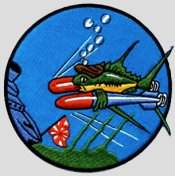
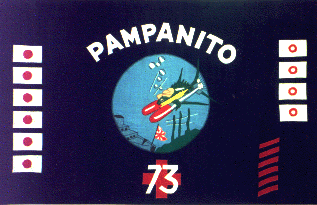
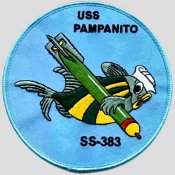
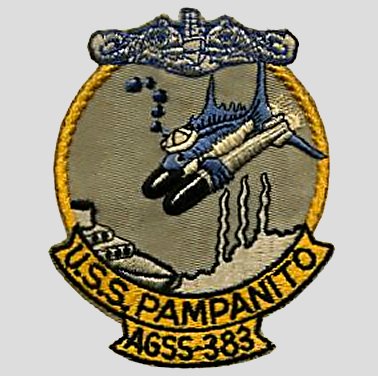
Patches on left contributed by Mike Smolinski, on right by Lester Palifka.
Please report any broken links or trouble you might come across to the Webmaster.
Please take a moment to let us know so that we can correct any problems and make your visit as enjoyable and as informative as possible.




| Click On Image For Full Size | Size | Image Description | Source | |
|---|---|---|---|---|
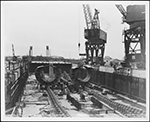 |
990k | Keel laying of the Picuda (SS-382) (left) and Pampanito (SS-383) (right) on 15 March 1943, Portsmouth Navy Yard, Portsmouth, NH. | National Archives Identifier: 38330013 Photo courtesy of catalog.archives.gov | |
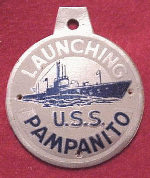 |
27k | Commemorative medallion on the occasion of the launching of the Pampanito (SS-383) on 12 July 1943. | Photo courtesy of Jack Treutle (of blessed memory). | |
 |
16k | Commemorative postmark issued on the occasion of the launching of the Pampanito (SS-383) on 12 July 1943. | Photo courtesy of Jack Treutle (of blessed memory). | |
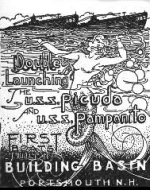 |
19k | Pampanito (SS-383), commemorative launching card at Portsmouth Navy Yard, Portsmouth, NH. 1943. | Photo courtesy of Lester Palifka. | |
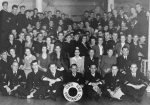 |
56k | Pampanito (SS-383), commissioning crew photo. | Photo courtesy of Lester Palifka. | |
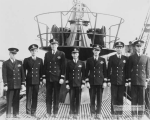 |
52k | Pampanito (SS-383), ship's officers, commissioning 1943. | Photo courtesy of Lester Palifka. | |
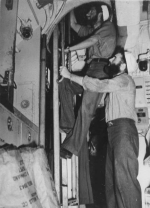 |
33k | Pampanito (SS-383), ship's crew in the galley, circa 1943-45. | Photo courtesy of Lester Palifka. | |
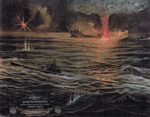 |
1.41k | Pampanito's (SS-383) 3rd war patrol (17 August-28 September 1944), a "wolfpack" operation with submarines Growler (SS-215) and Sealion (SS-315), was conducted in the South China Sea. On 12 September, she sank 10,509-ton transport Kachidoki Maru and 5,135 ton tanker Zuiho Maru and damaged a 3rd ship. I. R. Lloyd print of the Pampanito (SS-383) in WW II. |
Text courtesy of DANFS. USN photo courtesy of Darryl L. Baker. | |
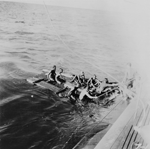 0838316 |
363k | Former British and Australian prisoners of war being rescued by the crew of USN submarine Pampanito (SS-383), on 15 September 1944. These men survived the sinking of the Japanese hell ship, the Rakuyo Maru by Sealion (SS-315) on 12 September 1944. | US Navy photo. This image is available from the Collection Database of the Australian War Memorial under the ID Number: P03651.005 via Rober Hurst. | |
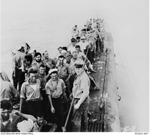 0838314 |
309k | Crew members of the submarine Pampanito (SS-383) gather on deck. This USN submarine sank the Japanese prisoner of war transport Kachidoki Maru on 12 September 1944. Pampanito later rescued a large group of Australian survivors, including some from Rakuyo Maru, herself sunk by Sealion (SS-315), and disembarked them at Saipan for subsequent repatriation to Australia in October 1944. | US Navy photo. This image is available from the Collection Database of the Australian War Memorial under the ID Number: P03651.007 via Rober Hurst. | |
 |
37k | Pampanito (SS-383) in July 1945 wearing Ms 32/3SS-B camouflage scheme. | Courtesy of The Floating Drydock, "Fleet Subs of WW II" by Thomas F. Walkowiak. | |
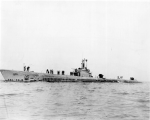 |
52k | Pampanito (SS-383) port side view underway in July of 1945. | Partial text courtessy of Richard Pekelney. Photo courtesy of Lester Palifka. |
|
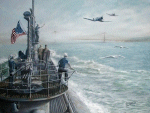 |
72k | Oil/alkyd on canvas by the artist John Meeks entitled "The Homecoming". The sub - proudly escorted by a few seagulls, is greeted by a pair of Navy "Corsairs" roaring out over the now peaceful Pacific. In the background, the Golden Gate Bridge invitingly looms out of the (obligatory...) fog banks that constantly drift over the Northern Californian coast. |
Photo & text courtesy of subart.net. | |
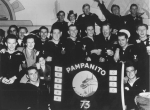 |
45k | Pampanito (SS-383), decommissioning crew photo. | Photo courtesy of Lester Palifka. | |
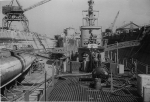 |
80k | Gurnard (SS-254) in drydock, at Hunters Point with the Pampanito (SS-383) on her port side. The DE in background could be Creamer DE-308 which was built and launched at Mare Island but never completed. There were 3 Mare Island DE's not completed and two were cut in half and pulled onto the large building ways at the yard and scrapped. It makes sense that the third one could have gone to Hunters Point for its appointment with the cutting torch. Gurnard came to Mare Island on 11/26/45 and was placed into Reserve on 11/27/45. |
Photo from the collection of CWO 4 Benton E. Buell, USN, courtesy of David Buell. Photo i.d. courtesy of Darryl L. Baker. |
|
 |
123k | Gurnard (SS-254) in drydock with Pampanito (SS-383)
as they are prepared for inactivation to the reserve fleet in October-November 1945.
Pampanito was inactivated and
decommissioned with Gurnard. Pampanito actually decommissioned after Gurnard, in early December 1945. The sailor in the photo is from Gurnard, TM2c Bill Parks. |
USN photo from the collection of CWO 4 Benton E. Buell, USN, courtesy of David Buell. | |
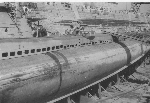 |
89k | Pampanito (SS-383) taken in October-November 1945 time-frame when both Gurnard (SS-254) and Pampanito were undergoing inactivation procedures preparatory to decommissioning into the reserve fleet. | USN photo from the collection of CWO 4 Benton E. Buell, USN, courtesy of David Buell. | |
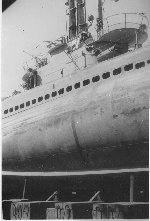 |
77k | Pampanito (SS-383) taken from the floor of the drydock, late 1945. | USN photo from the collection of CWO 4 Benton E. Buell, USN, courtesy of David Buell. | |
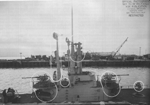 |
173k | Pampanito (SS-383) after a Hunters Point refit, 23 July 1945, with a new SV air-search radar on her separate radar mast and new periscope shears with a DF loop between the periscopes and an SJ mast abaft them. The object forward of the bridge fairwater is a 20 mm mount. | USN photo & text courtesy of U.S. Submarines Through 1945, An Illustrated Design History by Norman Friedman. Naval Institute Press & submitted by Robert Hurst. | |
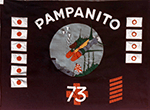 |
101k | ex Pampanito's (SS-383) battleflag. | Photo courtesy of Darryl L. Baker. | |
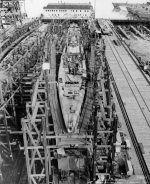 |
308k | Bow view of the Tiru (SS-416) under construction at Mare Island on 3 January 1946. Submarines in the background are decommisioned or will soon be: from front to rear are Bashaw (SS-241), Pampanito (SS-383), Mingo (SS-261), Gurnard (SS-254), Macabi (SS-375), Tunny (SS-282), Guavina (SS-362) and Sand Lance (SS-381). | USN photo # 18-46, courtesy of Darryl L. Baker. | |
 | 137k | Reserve fleet at Mare Island, circa January 1946. There are 52 submarines and 4 Sub Tenders in this photo. This photo is a Berthing list identifying the ships in the picture. | Photo commemorating 50 years, U. S. Submarine Veterans of WW II 1996 calendar, courtesy of Darryl L. Baker. | |
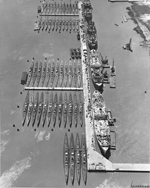 | 453k | Photo of the Reserve fleet at Mare Island, circa January 1946. There are 52 submarines and 4 Sub Tenders in this photo. Whether coincidental or on purpose, the number of boats in the photo is the same as that which were lost in WW II. From back to front and left to right, first group of 12 boats: Sand Lance (SS-381) Tunny (SS-282) Aspro (SS-309) Lionfish (SS-298) Guvania (SS-362) Sunfish (SS-281) Macabi (SS-375) Gurnard (SS-254) Pampanito (SS-383) Mingo (SS-261) Guitarro (SS-363) Bashaw (SS-241) From back to front and left to right, second group of 12 boats: Sealion (SS-315) Hammerhead (SS-364) Bream (SS-243) Seahorse (SS-304) Tinosa (SS-283) Pintado (SS-387) Mapiro (SS-376) Pipefish (SS-388) Moray (SS-300) Batfish (SS-310) Hackleback (SS-295) Bluegill (SS-242) From back to front and left to right, third group of 12 boats: Hawkbill (SS-366) Menhaden (SS-377) Perch (SS-313) Loggerhead (SS-374) Barbero (SS-317) Baya (SS-318) Hardhead (SS-365) Spadefish (SS-411) Springer (SS-414) Devilfish (SS-292) Kraken (SS-370) Dragonet (SS-293) From back to front and left to right, fourth group of 12 boats: Lamprey (SS-372) Piranha (SS-389) Manta (SS-299) Pargo (SS-264) Rancador (SS-301) Archerfish (SS-311) Mero (SS-378) Sawfish (SS-276) Spot (SS-413) Lizardfish (SS-373) Jallao (SS-368) Icefish (SS-367) From back to front and left to right, last group of 4 boats: Steelhead (SS-280) Puffer (SS-268) Stickleback (SS-415) Trepang (SS-412) From back to front, Submarine Tenders group of 4 ships: Pelias (AS-14) Aegir (AS-23) Euryale (AS-22) Griffin (AS-13) | Photo commemorating 50 years, U. S. Submarine Veterans of WW II 1996 calendar, courtesy of Darryl L. Baker. | |
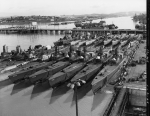 |
900k | Inactivated submarines at Mare Island on 3 January 1946. Front row left to right: Sand Lance (SS-381), next two could be Sealion (SS-315) and Seahorse (SS-304), Searaven (SS-196), Pampanito (SS-383), Gurnard (SS-254), Mingo (SS-261), Guitarro (SS-363), Bashaw (SS-241). Back row left to right: Unknown, Tunny (SS-282), next three could be Sargo (SS-188), Spearfish (SS-190), and Saury (SS-189), Macabi (SS-375), Sunfish (SS-281), Guavina (SS-362), Lionfish (SS-298), Piranha (SS-389). The Scabbardfish (SS-397) is docked in ARD-11 on the other side of the causeway. The mixture of boats from the Salmon/Sargo, Gato, and Balao classes illustrate the clear differences in the conning tower fairwaters and the periscope shears that can be used to identify boats. The high bridges with the uncovered support frames (the "covered wagon" look) of the Gato's and Salmon/Sargo's contrast with the low and sleek look of the Balao's. The fatter, more robust periscope shears of the Balao's are markedly different from the thinner shears with more supporting structure of the Gato's and Salmon/Sargo's . The differences in the pattern of the superstructure limber holes can also be used for identification purposes. The single row of large semi-circular holes identify Electric Boat or Manitowoc boats. A dual row of smaller rectangular holes mark the government built boats. Also note that the EB/Manitowoc boats have the deck mounted, T-shaped JP sonar head on the starboard side of the forward deck, while the government boats have it on the port side. EB/Manitowoc boats had the anchor on the starboard side, the government boats on the port side. A close look will show that some of the boats have had the anchor removed and the hawsepipe plated over as part of the mothball process. Most of the boats have the late war radar outfit of the SJ surface search (small dish) and SV air search (large dish). The Balao's and some of the Gato's have the SS dish mounted on a separate large mast aft of the periscopes. The older Salmon/Sargo's and Gato's have a much smaller mast. Searaven appears to have had her radars already removed. Searaven is actually sporting a late war SJ surface search antennae mounted to starboard of the periscopes. This is a rare installation. Most often it was mounted forward (early war) or aft (late war) of the 'scopes shears. Her air search set is a late war SD antennae mounted on a stub mast directly aft of the 'scopes. Searaven never received the much more capable SV air search set. Having been assigned to training duties after November, 1944 it was probably felt that the SV set was not necessary. One strange thing: almost all of the boats appear to have the outer doors of the forward torpedo tubes open. Even though the boats have an interlock system that prevents the breech and outer doors from being opened at the same time, this is an unusual thing to do and a potential source of catastrophic flooding. |
USN photo # 17-46, courtesy of Darryl L. Baker. Text courtesy of David Johnston |
|
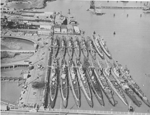 | 289k | Inactivated submarines at Mare Island in early 1946. Front row left to right: Sand Lance (SS-381), next two could be Sealion (SS-315) and Seahorse (SS-304), Searaven (SS-196), Pampanito (SS-383), Gurnard (SS-254), Mingo (SS-261), Guitarro (SS-363), Bashaw (SS-241). Back row left to right: Unknown, Tunny (SS-282), next three could be Sargo (SS-188), Spearfish (SS-190), and Saury (SS-189), Macabi (SS-375), Sunfish (SS-281), Guavina (SS-362), Lionfish (SS-298), Piranha (SS-389). The Scabbardfish (SS-397) is docked in ARD-11 on the other side of the causeway. Tiru (SS-416) is on the ways in upper left hand side of photo. Two ferry boats (to the right of Tiru's ways) are YHB-2 / [ex-Post of Stockton] and YHB-21 / [ex-Tamalpais]. | Photo i.d. courtesy of Darryl L. Baker. USN photo courtesy of Scott Koen & ussnewyork.com. |
|
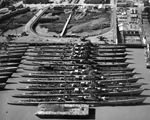 |
1.93k | Aerial view of decommissioned submarine at Mare Island Reserve Fleet taken on 18 March 1946. The majority of the personnel topside are navy personnel. I would say they are still inactivating the subs. Submarines are from top to bottom: Bashaw (SS-241), Guitarro (SS-363), Mingo (SS-261), Gurnard (SS-254), Pampanito (SS-383), Sand Lance (SS-381), Bream (SS-243), Hammerhead (SS-364) Sealion (SS-315), Tinosa (SS-283) & Pintado (SS-387) plus YC 316. |
USN photo courtesy of the Vallejo Naval & Historical Museum via Darryl L. Baker. | |
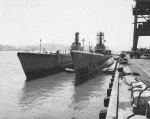 |
207k | Sunfish (SS-281) & Pampanito (SS-383) along the water front at Mare Island in August 1960. | Photo courtesy of Jim Richardson. | |
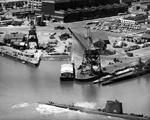 | 1.30k | Pomfret (SS-391) off Mare Island on 23 August 1962. YRB-18 is in the background along with the sterns of two decommissioned submarines, the Pampanito (SS-383) inboard & Sunfish (SS-281), with her after deck being removed. | Photo # 55846-8-62 TH from the collection of the Vallejo Naval and Historical Museum via Darryl L. Baker. Photo i.d. & text courtesy of Ric Hedman, Dave Johnston & Robert Morgan. |
|
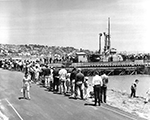 | 1.23k | Crowd waiting to board the Naval Reserve Training submarine Pampanito (SS-383) at Mare Island during Armed Forces Day 15 May 1965. | USN photo courtesy of the Vallejo Naval & Historical Museum via Darryl L. Baker. | |
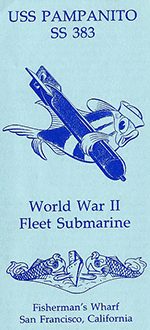 | 270k | 5 page Welcome Aboard the Pampanito (SS-383) PDF. | USN photos courtesy of Scott Koen & ussnewyork.com. | |
 |
107k | Pampanito (SS-383) was drydocked during her 1987 overhaul. Along with having many topside items restored and repaired she also got a fresh coat of bottom paint. Also, hull plates welded over openings were checked. Note the detail of the bilge keel and where the shaft penetrates the hull. This view is of the port side looking forward. | Courtesy of The Floating Drydock, "Fleet Subs of WW II" by Thomas F. Walkowiak. | |
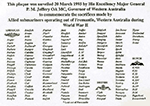 |
365k | This plaque was unveiled 20 March 1995 by His Excellency Major General P.M. Jeffery OA MC, Governor of Western Australia to commemorate the sacrifices made by Allied submarines that operated out of Fremantle, Western Australia during WW II. | Photo courtesy of Ron Reeves (of blessed memory). | |
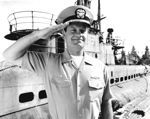 | 722k | LCDR Tom Dodge (played by Kelsey Grammer) welcomes you to the Stingray (SS-161). "Down Periscope" began shooting on 6 May 1995 and finished on 27 July. The Pampanito (SS-383), a Balao-class submarine from World War II, now a museum ship and memorial in San Francisco on display to the public at Pier 45 played the part of the Stingray. The Pampanito could not move under her own power. The underwater shots were scale models. The surface shots actually were the Pampanito, however she was being towed. | Photo courtesy of Bill Gonyo. | |
 0838332 |
3.93k | Pampanito (SS-383) in mothballs before becoming a memorial. This photo is from the 1995 movie Down Periscope. This segment was filmed in the Susuin Bay Reserve Fleet. | Text i.d. courtesy of Richard Pekelney. Photo courtesy of John Hummel. | |
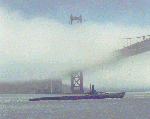 |
17k | Pampanito (SS-383) appears here in the movie Down Periscope. | Photo by Robert Taylor, copyright by San Francisco Maritime National Park Association [SFMNPA]. Ms. Diane Cooper curator, Pampanito (SS-383) collection. | |
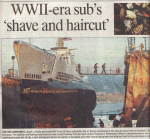 |
130k | Alameda Journal, Volume 18, Number 107, Friday, January 2007 edition showing the Pampanito (SS-383) in drydock. | Courtesy of Robert M. Cieri. | |
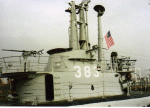 |
99k | Pampanito's (SS-383) conning tower with 40mm & 20mm gun mount, 27 January 2007. | Courtesy of Robert M. Cieri. | |
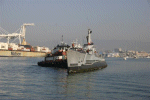 |
39k | Pampanito (SS-383) starting to enter drydock for some much needed repairs, January 2007. | Courtesy of Jack Treutle (of blessed memory). | |
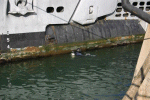 |
56k | Diver inspecting the underside of the Pampanito (SS-383) in drydock, January 2007. | Courtesy of Jack Treutle (of blessed memory). | |
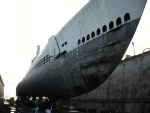 |
100k | Looking up from down under of the Pampanito (SS-383) while in drydock, January 2007. | Courtesy of Jack Treutle (of blessed memory). | |
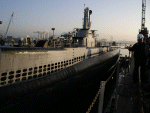 |
321k | Portside bow view Pampanito (SS-383) in drydock, January 2007. | Courtesy of Jack Treutle (of blessed memory). | |
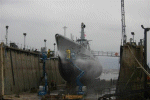 |
54k | The Pampanito (SS-383) would receive two coats of gray epoxy and black anti-fouling while in drydock, January 2007. | Courtesy of Jack Treutle (of blessed memory). | |
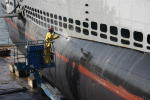 |
73k | The Pampanito (SS-383) would receive two coats of gray epoxy and black anti-fouling while in drydock, January 2007. | Courtesy of Jack Treutle (of blessed memory). | |
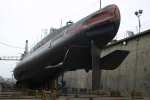 |
54k | Stern view of the Pampanito (SS-383) while in drydock, January 2007. | Courtesy of Jack Treutle (of blessed memory). | |
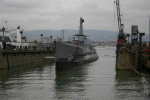 |
67k | The Pampanito (SS-383) has her drydock flooded, or "fleeted", so the previously covered area of the boat which was resting on blocks while she was in drydock can be tended to; just barely floating the boat so they could move her aft about 3 feet then raise the drydock again so that they can get to the area where the blocks were and sandblast and paint it. | Partial text and photo courtesy of Jack Treutle (of blessed memory). | |
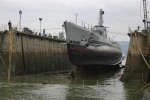 |
54k | The Pampanito (SS-383) following "fleeting". | Photo courtesy of Jack Treutle (of blessed memory). | |
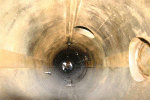 |
59k | Looking through the business end of the Pampanito (SS-383) in drydock, February 2007. | Courtesy of Jack Treutle (of blessed memory). | |
 |
100k | Page 1 of the Alameda California Journal, Volume 19, Number 111 for 9 February 2007 article on the Pampanito's (SS-383) drydocking, February 2007. | Courtesy of Robert M. Cieri. | |
 |
252k | Page 2 of the Alameda California Journal, Volume 19, Number 111 for 9 February 2007 article on the Pampanito's (SS-383) drydocking, February 2007. | Courtesy of Robert M. Cieri. | |
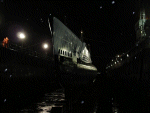 |
65k | Wake up time for the Pampanito (SS-383) to return to Pier 45 starts at 4:00 AM as the boat is roused by the flooding of the drydock. | Courtesy of Jack Treutle (of blessed memory). | |
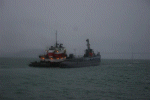 |
43k | Pampanito (SS-383) returns home. | Courtesy of Jack Treutle (of blessed memory). | |
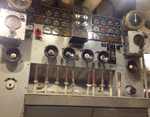 |
9.32k | 27 images of the Pampanito (SS-383), 2014. | Photos courtesy of Chris Edwards. | |
| Back To The Main Photo Index | Back To the Submarine Index |
|
Comments, Suggestions, E-mail Webmaster. |
|
This page is created by Michael Mohl, and maintained by Michael Mohl All Pages © 1996 - 2025 NavSource History |